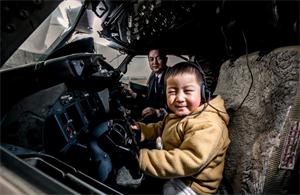Six ocean guardians' global odyssey
Updated: 2016-01-28 15:14 By Song Jingyi (chinadaily.com.cn)
 |
|
Claude Thelier and Olivier Rouvillois eats lunch in a very small and narrow space on board. [Photo provided by Race For Water Foundation to chinadaily.com.cn. Race for Water 2015 / Peter Charaf] |
Q: What kind of preparations did you make before expedition?
A: We calculated that the whole navigation would last nine months to go into all five main trash gyres. We used our ambassador boat, the MOD70 sailing trimaran, which was used for racing and not for such expeditions. The distance we needed to sail was the equivalent of two world tours (more than 40,000 nautical miles). Therefore, we needed to configure it in order to ship the scientific materials as well as the necessary things to live on board.
Q: During the voyage, what was your biggest obstacle?
A: The noise! We are immersed in a "deafening empire". When we gain speed, every single centimeter of the trimaran is noisy and the worst part is that we get used to it. Our crew's ears have never gotten respite since aboard the MOD70 Race for Water.
Each zone has specific noises: whistling or squealing noises in the hold, sprays smashing into the porthole in the kitchen and the permanent growl of the water in the whole central hull. Whether it is lowered or raised, the drift is also always very loud.
Actually, the calmer place in this "deafening empire" is our little hut on the deck, unless we get attacked by an enormous wave or by kamikaze flying fishes.
Q: Could you tell me more about how you balance scientific investigations and daily life?
A: The catamaran is only 21 meters long and has only one small cabin with two beds and a cooking corner. There is no heating, no shower and no toilet. Because we have five to six people on board, so we have to take sleeping shifts of two hours and stay three hours awake. But if there are storms or a typhoons like on the leg from Hawaii to Yokohama, nobody is able to sleep at all.
Q: During the voyage, what have impressed you the most?
A: Two things left the deepest impressions on me. The first one was when our ship capsized in the Indian Ocean. As we were navigating by night with 18 to 20 knots of wind, a strong gust of wind turned the boat over. Fortunately, the crew was safe and unhurt inside the upturned main hull. Our shore team worked immediately on solutions to recuperate both crew and yacht. The personnel at the military base in Diego Garcia, less than 100 miles away, also agreed to assist the team. The crew was also really shocked to see how much trash there was to see on every island we visited, from the most famous ones (such as Easter Island) to the most remote one. Here is an example of a very remote island on which we went. Nobody lives on this island, but so much trash lost in the ocean.
Not the end, but a new beginning
Q: Do you think there will be another race?
A: The plan is that we will keep going. Differently, since 2015 is the first step. The second step will be more about action. There will be other missions. I'm not sure if we can call them races yet, because we are not sure what is going to happen.
In 2016, we have launched the Pilot Project which is going to transform marine plastic waste in electricity. The idea is to implement the first pilot project in Rio, during the Olympic Games. We will know very soon if we can confirm that we can go there with our new ambassador boat, the race for water solar vessel.
Q: Will next year's plan include China?
A: We won't be coming back to China in 2016, unfortunately. However, our objective is to duplicate our project and its positive effects as soon as we can, so maybe in the following years, we will come back to China with innovative technology.







